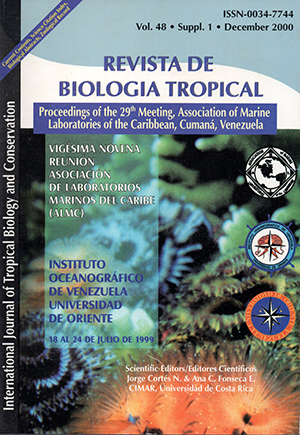Abstract
The year 1996 had a high pluviosity in Morrocoy National Park (western coastal zone, Venezuela) and low salinity in December 1996 affected the seagrass beds, dominated by Thalassia testudinum. Patches without T. testudinum were observed in localities of the park that used to have very dense populations of this plant. Sampling was done at Las Luisas to determine leaf productivity, turnover rate, short shoot density and relative biomass of plant sections, in order to compare with data obtained in September 1996, previous to the event. Green leaves, roots and rhizomes were the most affected parts. Mean green leaf biomass decreased in January and February 1997 to 5% of the plant's total biomass; mean root biomass decreased in March to 40% and mean rhizome biomass decreased in February to 30%. The density of the active short shoots decreased to a minimum in February, but in April it reached a value similar to that of September 1996. The density of the inactive short shoots decreased to a minimum in March, and they dissappeared in April, matching the increasing density of the active short shoots between these two months. In February 1997, 56% of the inactive short shoots showed evidence of leaf initiation. In January 1997 the leaf productivity and turnover rate values (2.72 it 0.35 g/m2/d and 2.15% leaf DW/d) were similar to the annual mean previously determined from Las Luisas (2.35 it 0.72 g/m2/d and 1.96% leaf DW/d). Nevertheless, the values of productivity and turnover rate detected at Las Luisas in April 1997 (4.88 it 2.14 g/m2/d and 4.66% leaf DW/d) were higher than those values previously reported for this location. In response to the mortality episode, the leaf productivity and turnover rate of T testudinum increased and the leaf initiation was activated in the inactive short shoots.##plugins.facebook.comentarios##

This work is licensed under a Creative Commons Attribution 4.0 International License.
Copyright (c) 2000 Revista de Biología Tropical
Downloads
Download data is not yet available.


